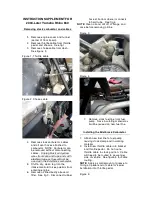
Automatic Emergency Braking
Model S is designed to determine the distance from a
detected object traveling in front of it. When a frontal
collision is considered unavoidable, Automatic
Emergency Braking is designed to apply the brakes to
reduce the vehicle's speed and therefore, the severity of
the impact. The amount of speed that is reduced
depends on many factors, including driving speed and
environment.
When Automatic Emergency Braking applies the brakes,
the instrument panel displays a visual warning and
sounds a chime. You may also notice abrupt downward
movement of the brake pedal. The brake lights turn on
to alert other road users that you are slowing down.
Emergency braking in progress
Automatic Emergency Braking operates only when
driving between approximately 3 mph (5 km/h) and 90
mph (150 km/h).
In addition, your vehicle may apply the brakes,
regardless of driving speed, to prevent or mitigate a
subsequent impact after an initial collision.
Automatic Emergency Braking does not apply the
brakes, or stops applying the brakes, when:
• You turn the steering yoke sharply.
• You press and release the brake pedal while
Automatic Emergency Braking is applying the brakes.
• You accelerate hard while Automatic Emergency
Braking is applying the brakes.
• The vehicle, motorcycle, bicycle, or pedestrian is no
longer detected ahead.
Automatic Emergency Braking is always enabled when
you start Model S. To disable it for your current drive,
touch
Controls
>
Autopilot
>
Automatic Emergency
Braking
. Even if you disable Automatic Emergency
Braking, your vehicle may still apply the brakes after
detecting an initial collision to reduce further impact.
WARNING:
It is strongly recommended that you
do not disable Automatic Emergency Braking. If
you disable it, Model S does not automatically
apply the brakes in situations where a collision is
considered likely.
WARNING:
Automatic Emergency Braking is
designed to reduce the severity of an impact. It is
not designed to avoid a collision.
WARNING:
Several factors can affect the
performance of Automatic Emergency Braking,
causing either no braking or inappropriate or
untimely braking, such as when a vehicle is
partially in the path of travel or there is road
debris. It is the driver’s responsibility to drive
safely and remain in control of the vehicle at all
times. Never depend on Automatic Emergency
Braking to avoid or reduce the impact of a
collision.
WARNING:
Automatic Emergency Braking is
designed to reduce the impact of frontal collisions
only and does not function when Model S is in
Reverse.
WARNING:
Automatic Emergency Braking is not a
substitute for maintaining a safe traveling distance
between you and the vehicle in front of you.
WARNING:
The brake pedal moves downward
abruptly during automatic braking events. Always
ensure that the brake pedal can move freely. Do
not place material under or on top of the driver’s
floor mat (including an additional mat) and always
ensure that the driver’s floor mat is properly
secured. Failure to do so can impede the ability of
the brake pedal to move freely.
Obstacle-Aware Acceleration
Obstacle-Aware Acceleration is designed to reduce the
impact of a collision by reducing motor torque and in
some cases applying the brakes, if Model S detects an
object in its driving path. The instrument panel displays
a visual warning and sounds a chime when the brakes
are automatically applied. For example, Model S, while
parked in front of a closed garage door with Drive
engaged, detects that you have pressed hard on the
accelerator pedal. Although Model S still accelerates and
hits the garage door, the reduced torque may result in
less damage.
Obstacle-Aware Acceleration is designed to operate
only when all of these conditions are simultaneously
met:
• Drive or Reverse is engaged.
• Model S is stopped or traveling less than 10 mph (16
km/h).
• Model S detects an object in its immediate driving
path.
To disable Obstacle-Aware Acceleration, touch
Controls
>
Autopilot
>
Obstacle-Aware Acceleration
.
WARNING:
Obstacle-Aware Acceleration is
designed to reduce the severity of an impact. It is
not designed to avoid a collision.
Collision Avoidance Assist
115
Active Safety Features
















































